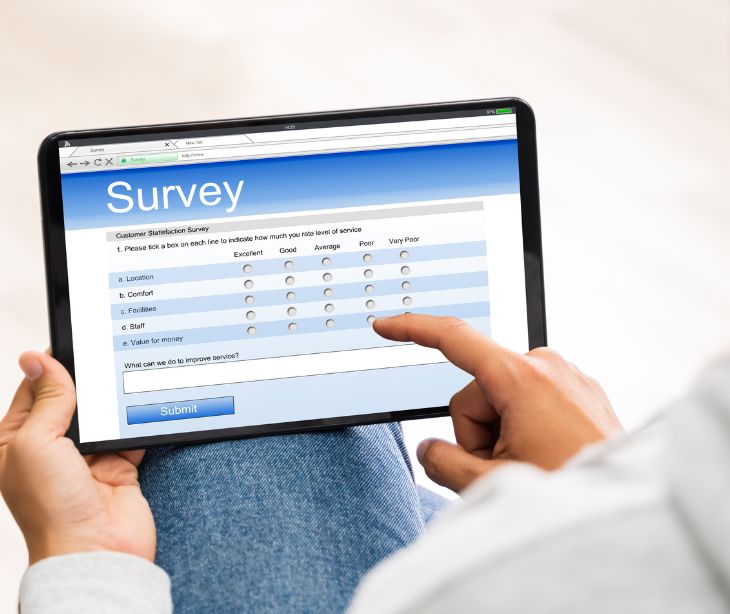
Individuals are likely to share negative experiences with at least 16 people. This statistic puts into perspective the need to gain insight into the patient experience within healthcare organizations. However, this can be difficult, as patients often ignore feedback forms. Understanding why feedback forms are ignored and how to improve customer communication channels offers a new avenue to improving patient outcomes.
Alternative methods of collecting patient feedback
Traditional methods may not effectively reach all patient demographics or accommodate different preferences and capabilities. Diversifying the channels through which feedback forms are distributed, such as incorporating electronic methods like HIPAA compliant email and the methods of providing feedback, can be beneficial. This approach allows patients to choose the method that best suits their needs, encouraging broader participation. As a result, healthcare providers receive a more comprehensive and diverse set of responses, offering deeper insights into patient experiences and satisfaction.
See also: Are patient satisfaction surveys HIPAA compliant?
Factors contributing to patients not responding to feedback forms
Feedback fatigue
Patients who frequently visit healthcare facilities may experience feedback fatigue, feeling overwhelmed by the constant requests for feedback across different services and providers. This over-solicitation can lead to disengagement from feedback processes.
Emotional state
The emotional state of patients when they receive the feedback form can impact their willingness to respond. Patients who are stressed, anxious, or emotionally drained from their healthcare experience may lack the mental bandwidth to provide feedback.
Mismatched feedback channels
The medium through which feedback is requested might not align with patients' preferences or abilities. For instance, older patients or those uncomfortable with technology might be less likely to engage with digital feedback forms, preferring face-to-face or paper-based methods.
Lack of immediate relevance
Patients might prioritize feedback forms lower if the questions asked do not immediately relate to their most pressing concerns or experiences. Feedback forms that fail to address the specific services or interactions that patients deem most necessary will be less compelling.
Perceived lack of anonymity
Even when assured of confidentiality, patients may doubt the anonymity of their responses, especially if the feedback could be perceived as critical or negative towards specific staff members. This concern can inhibit open and honest feedback.
Insufficient explanation of feedback use
To motivate patients to provide feedback, healthcare providers should explain how their feedback is used to make improvements. This can be achieved by offering examples of past improvements and providing an explicit explanation of the feedback loop.
No follow-up on previous feedback
Patients who have provided feedback in the past but have not seen any acknowledgment or follow-up may feel that their input is disregarded. A lack of visible response or communication about how feedback has been acted upon can deter future participation.
Digital divide
The shift towards online or digital feedback mechanisms can exclude patients without access to the necessary technology or the skills to use it. This digital divide can prevent certain groups of patients from providing feedback.
See also: Top 7 HIPAA compliant email marketing services
How to create an effective patient feedback form
Creating an effective patient feedback form involves understanding and addressing the specific needs and experiences of patients.
- Start by ensuring the form is concise and straightforward, focusing on clear, jargon-free language to accommodate a diverse range of health literacy levels.
- Incorporate questions directly relevant to the patients' experiences, allowing them to provide specific insights into what worked well and what could be improved.
- Enhance the likelihood of comprehensive feedback, mix open-ended questions that invite detailed responses with closed-ended ones that can be quickly answered.
- Design the form with accessibility in mind, offering it in multiple formats — paper, digital, and others — to cater to different preferences and abilities.
- Privacy concerns should be addressed upfront by clearly stating how the feedback will be kept confidential and used solely for improving service quality.
- Demonstrate the value of the feedback process by communicating back to patients about the changes and improvements made as a result of their input.
FAQs
How can healthcare providers get more patients to complete feedback forms?
Providers can encourage more patients to complete feedback forms by simplifying the forms, ensuring anonymity, explaining the importance and impact of feedback, and offering multiple convenient methods for submission.
Is timing a factor in patient response rates to feedback forms?
Patients are more likely to respond to feedback forms if provided at a convenient time, such as shortly after receiving care, when the experience is fresh in their minds.
How do privacy concerns stop patients’ willingness to provide feedback?
Privacy concerns can deter patients from providing feedback. Patients need assurance that their responses are anonymous and that their privacy will be protected to feel comfortable sharing honest feedback.
Subscribe to Paubox Weekly
Every Friday we'll bring you the most important news from Paubox. Our aim is to make you smarter, faster.




